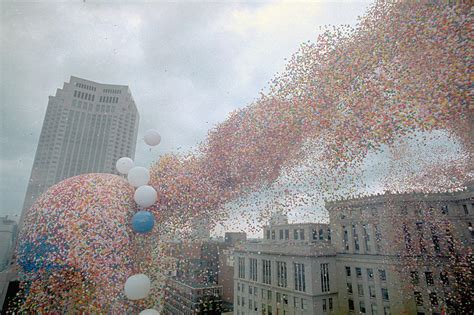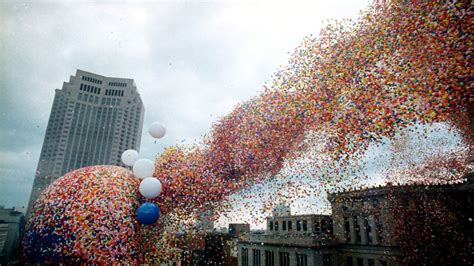
A 1986 balloon release in Cleveland, Ohio, intended to be a world record-breaking spectacle and fundraiser, quickly devolved into a costly environmental and logistical nightmare, now serving as a persistent cautionary tale about unintended consequences. Balloonfest ’86, which unleashed nearly 1.5 million balloons, caused flight delays, contributed to the drowning of two individuals, and inflicted significant environmental damage, proving that even well-intentioned events can lead to unforeseen disasters.
Balloonfest ’86: A Cautionary Tale Still Inflating Today
On September 27, 1986, Cleveland, Ohio, became the stage for what organizers hoped would be a triumphant world record: the mass release of nearly 1.5 million balloons. Balloonfest ’86 was conceived as a visually stunning spectacle and a fundraising event for the United Way of Cleveland. Instead, it rapidly transformed into an environmental and logistical quagmire, leaving a legacy of lessons about the perils of unchecked ambition and the unforeseen consequences of large-scale events. More than three decades later, the event remains a stark reminder of how even well-intentioned projects can quickly spiral into disaster.
The ambitious project was the brainchild of the United Way of Cleveland, aiming to garner national attention and raise money for local charities. Organizers meticulously planned the event, involving thousands of volunteers who spent countless hours inflating and netting the massive number of balloons inside a giant structure erected in downtown Cleveland. The event was designed to be a symbol of hope and unity, with the vibrant colors of the balloons set against the backdrop of the city skyline.
Originally scheduled for earlier in the day, the launch was delayed due to inclement weather. When the balloons were finally released, they ascended into the sky in a breathtaking display. However, the celebratory atmosphere was short-lived. As the balloons floated eastward, they began to descend, blanketing the city and surrounding areas in a sea of colorful latex.
The immediate aftermath of Balloonfest ’86 was chaotic. The sheer volume of balloons disrupted air traffic at Burke Lakefront Airport, forcing authorities to temporarily shut down the airfield. The balloons also drifted onto Lake Erie, hampering search efforts for two missing fishermen.
Adding to the calamity, the influx of balloons into the environment caused widespread damage. They littered waterways, fields, and roadways, posing a threat to wildlife and disrupting ecosystems. Cleanup efforts proved to be extensive and costly.
The most tragic consequence of Balloonfest ’86 was its potential contribution to the deaths of Raymond Broderick and David Lampe. The two men had been reported missing the day of the balloon release after they went fishing on Lake Erie. Their bodies were later recovered, and while the balloons were not definitively proven to be the cause of their drowning, the massive influx of balloons into the lake hampered search efforts, potentially delaying their rescue. The wives of the deceased men filed lawsuits against United Way of Cleveland, seeking compensation for the distress and suffering caused by the incident. The lawsuits were eventually settled out of court for an undisclosed amount.
The event also caused significant disruption and financial losses for local businesses. The balloons clogged machinery, disrupted operations, and created hazardous conditions. For example, a horse farm owned by Louise Nowakowski, located miles east of Cleveland, suffered significant damage. The balloons spooked her Arabian horses, causing them to injure themselves. Nowakowski sued United Way for $100,000 in damages and settled out of court for an undisclosed sum.
In the aftermath of Balloonfest ’86, organizers faced widespread criticism and condemnation. Environmental groups decried the event as an irresponsible act of pollution, while local residents expressed outrage at the disruption and damage it caused. The United Way of Cleveland, which had hoped to generate positive publicity and goodwill, found itself embroiled in controversy and legal battles. The event severely tarnished the organization’s reputation and raised questions about its decision-making process.
Beyond the immediate fallout, Balloonfest ’86 served as a crucial learning experience for event organizers and city officials worldwide. It highlighted the need for thorough risk assessments, comprehensive contingency plans, and a greater awareness of the environmental impact of large-scale events. The incident led to stricter regulations on mass balloon releases in many areas, with many jurisdictions banning them altogether.
The legacy of Balloonfest ’86 extends far beyond Cleveland. The event has become a case study in environmental planning and disaster prevention, taught in universities and professional development programs. It serves as a stark reminder of the need to carefully consider the potential consequences of even the most well-intentioned actions.
Moreover, Balloonfest ’86 contributed to a growing awareness of the harmful effects of balloon litter on the environment. Balloons, particularly those made of latex, can take years to decompose and pose a significant threat to wildlife. Animals can become entangled in balloon strings or ingest balloon fragments, leading to injury or death. The incident helped galvanize efforts to promote alternatives to balloon releases, such as planting trees or organizing community cleanups.
The environmental concerns highlighted by the event led to an increased focus on sustainable event planning. Event organizers are now more likely to consider the environmental impact of their activities and to implement measures to minimize waste, reduce pollution, and protect natural resources.
In the years since Balloonfest ’86, Cleveland has made significant strides in environmental protection and urban revitalization. The city has invested in green infrastructure, promoted sustainable transportation, and implemented programs to reduce pollution and improve air quality. The lessons learned from the event have helped shape Cleveland’s approach to environmental stewardship and community development.
Balloonfest ’86 serves as a poignant reminder that large-scale events, while often intended to bring joy and unity, can have profound and lasting consequences. The event underscores the importance of careful planning, risk assessment, and a commitment to environmental responsibility. Its legacy continues to inform event management practices and environmental policies around the world.
The event remains a subject of discussion among meteorologists, environmental scientists, and event planners. They use the event to illustrate the complexities of weather forecasting, the challenges of managing large-scale events, and the importance of environmental stewardship. The story of Balloonfest ’86 is not just a local anecdote but a global lesson.
The cautionary tale of Balloonfest ’86 also highlights the importance of considering the ethical implications of large-scale events. Organizers have a responsibility to ensure that their activities do not cause harm to the environment, endanger public safety, or infringe on the rights of others. Balloonfest ’86 serves as a reminder that even well-intentioned actions can have unintended and harmful consequences if they are not carefully considered.
Balloonfest ’86 prompted significant changes in regulations governing mass balloon releases. Many states and municipalities have enacted laws that restrict or prohibit the release of large numbers of balloons, citing concerns about environmental pollution and the safety of wildlife. These regulations are designed to prevent similar incidents from occurring in the future.
In addition to regulatory changes, Balloonfest ’86 also led to increased public awareness of the environmental impact of balloons. Many individuals and organizations have taken steps to reduce their use of balloons and to promote alternatives, such as planting trees or organizing community cleanups. This increased awareness has helped to reduce the amount of balloon litter in the environment.
The incident also served as a catalyst for the development of new technologies and strategies for managing large-scale events. Event organizers now have access to sophisticated tools for weather forecasting, risk assessment, and crowd control. These tools can help them to anticipate potential problems and to take steps to prevent them from occurring.
Balloonfest ’86 stands as a stark reminder of the importance of humility in the face of nature. Organizers must recognize that they cannot fully control the environment and that even the best-laid plans can be disrupted by unforeseen circumstances. The event underscores the need for flexibility, adaptability, and a willingness to adjust plans in response to changing conditions.
The enduring legacy of Balloonfest ’86 is a testament to the power of unintended consequences. The event serves as a cautionary tale for anyone involved in planning or managing large-scale events. It underscores the importance of careful planning, thorough risk assessment, and a commitment to environmental responsibility. The lessons learned from Balloonfest ’86 continue to inform event management practices and environmental policies around the world.
Balloonfest ’86 remains a significant event in Cleveland’s history, a moment that exposed the vulnerability of even the most ambitious projects to unforeseen circumstances. The event’s lasting impact lies in its contribution to our understanding of the intricate relationship between human ambition and environmental stewardship.
In-depth Analysis and Expanded Context
Balloonfest ’86 serves as a comprehensive case study in the potential pitfalls of large-scale events, offering valuable lessons in environmental responsibility, risk management, and community impact. Beyond the immediate visual spectacle and fundraising aspirations, the event’s legacy lies in its unintended consequences and the subsequent changes it spurred in event planning and environmental awareness.
The meticulous planning leading up to the event underscores the complexity of organizing such a massive undertaking. Thousands of volunteers dedicated countless hours to inflating and netting the balloons, highlighting the community involvement and the ambitious scope of the project. The choice of balloons as the central element was intended to symbolize hope and unity, reflecting the United Way’s mission to uplift the community.
However, the unforeseen challenges that arose during and after the event revealed critical shortcomings in risk assessment and contingency planning. The delayed launch due to inclement weather set off a chain of events that ultimately led to the disaster. The sheer volume of balloons, combined with unfavorable wind conditions, overwhelmed the city’s infrastructure and natural environment.
The disruption to air traffic at Burke Lakefront Airport illustrates the potential for large-scale events to impact essential services. The temporary shutdown of the airfield disrupted flights, causing delays and inconvenience for travelers. This incident highlights the need for event organizers to coordinate closely with transportation authorities to minimize disruptions and ensure public safety.
The impact on Lake Erie, particularly the hampering of search efforts for the missing fishermen, underscores the tragic consequences that can arise from environmental disasters. The balloons that landed in the lake made it difficult for search teams to locate the missing men, potentially delaying their rescue. This incident emphasizes the importance of considering the potential impact of events on aquatic environments and the need for swift and effective response measures.
The damage to local businesses, such as Louise Nowakowski’s horse farm, highlights the economic costs associated with environmental disasters. The balloons spooked her Arabian horses, causing them to injure themselves, resulting in significant financial losses for Nowakowski. This incident illustrates the need for event organizers to compensate businesses and individuals who suffer damages as a result of their activities.
The lawsuits filed against the United Way of Cleveland reflect the legal and ethical responsibilities of event organizers. The families of the deceased fishermen and the owner of the horse farm sought compensation for the distress, suffering, and financial losses they incurred as a result of the event. These lawsuits underscore the importance of accountability and the need for event organizers to be prepared to address the consequences of their actions.
The widespread criticism and condemnation faced by the United Way of Cleveland highlight the reputational risks associated with environmental disasters. The organization, which had hoped to generate positive publicity and goodwill, found itself embroiled in controversy and legal battles. This incident serves as a reminder that reputation is a valuable asset and that event organizers must take steps to protect it.
The stricter regulations on mass balloon releases that followed Balloonfest ’86 demonstrate the power of public policy to prevent environmental disasters. Many states and municipalities enacted laws that restrict or prohibit the release of large numbers of balloons, citing concerns about environmental pollution and the safety of wildlife. These regulations are designed to prevent similar incidents from occurring in the future.
The increased public awareness of the environmental impact of balloons underscores the importance of education and outreach. Many individuals and organizations have taken steps to reduce their use of balloons and to promote alternatives, such as planting trees or organizing community cleanups. This increased awareness has helped to reduce the amount of balloon litter in the environment.
The development of new technologies and strategies for managing large-scale events reflects the ongoing efforts to improve event planning and disaster prevention. Event organizers now have access to sophisticated tools for weather forecasting, risk assessment, and crowd control. These tools can help them to anticipate potential problems and to take steps to prevent them from occurring.
The enduring legacy of Balloonfest ’86 is a testament to the power of unintended consequences. The event serves as a cautionary tale for anyone involved in planning or managing large-scale events. It underscores the importance of careful planning, thorough risk assessment, and a commitment to environmental responsibility. The lessons learned from Balloonfest ’86 continue to inform event management practices and environmental policies around the world.
Frequently Asked Questions (FAQ)
1. What was Balloonfest ’86 and what was its purpose?
Balloonfest ’86 was a large-scale event held in Cleveland, Ohio, on September 27, 1986. The United Way of Cleveland organized it as a fundraising effort and an attempt to break the world record for the most balloons released simultaneously. The goal was to raise money for local charities and generate positive publicity for the organization.
2. What went wrong during Balloonfest ’86?
Several factors contributed to the event turning into a disaster. Inclement weather caused a delay in the launch, and when the balloons were eventually released, unfavorable wind conditions caused them to descend rapidly over the city and surrounding areas. This led to disruptions in air traffic, hampered search efforts for missing individuals on Lake Erie, and caused widespread environmental pollution.
3. What were the environmental and economic consequences of Balloonfest ’86?
The environmental consequences were significant, with balloons littering waterways, fields, and roadways. This posed a threat to wildlife and disrupted ecosystems. Economically, the event caused disruptions to businesses, including a horse farm that suffered damage due to spooked animals. Cleanup efforts were extensive and costly.
4. How did Balloonfest ’86 impact the search for two missing fishermen?
The massive influx of balloons into Lake Erie hampered search efforts for Raymond Broderick and David Lampe, who had been reported missing the day of the balloon release. The balloons made it difficult for search teams to locate the men, potentially delaying their rescue. The bodies of the fishermen were later recovered.
5. What lessons were learned from Balloonfest ’86, and how has it influenced event planning since then?
Balloonfest ’86 taught valuable lessons about the importance of thorough risk assessments, comprehensive contingency plans, and environmental responsibility in event planning. It led to stricter regulations on mass balloon releases in many areas and increased awareness of the harmful effects of balloon litter on the environment. The event now serves as a case study in environmental planning and disaster prevention, highlighting the need to consider the potential consequences of even well-intentioned actions.









